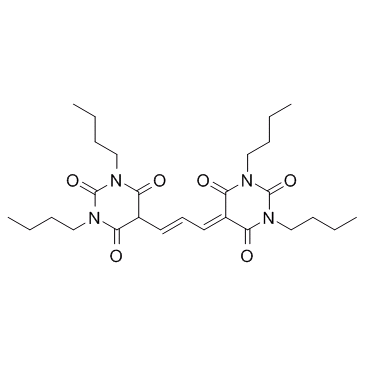DiSBAC2(5)

DiSBAC2(5) structure
|
Common Name | DiSBAC2(5) | ||
|---|---|---|---|---|
| CAS Number | 70363-83-6 | Molecular Weight | 516.63 | |
| Density | N/A | Boiling Point | N/A | |
| Molecular Formula | C27H40N4O6 | Melting Point | N/A | |
| MSDS | USA | Flash Point | N/A | |
Use of DiSBAC2(5)DiBAC4(3) is a voltage-sensitive fluorescent dye (λex=490 nm, λem=505 nm). |
| Name | Bis(1,3-dibutylbarbituric acid) trimethine oxonol |
|---|---|
| Synonym | More Synonyms |
| Description | DiBAC4(3) is a voltage-sensitive fluorescent dye (λex=490 nm, λem=505 nm). |
|---|---|
| Related Catalog | |
| In Vitro | The membrane hyperpolarization induced by 10 μM Evans blue (EB) in HEKBKα is clearly observed with DiBAC4(3), while the change in membrane potential (MP) by addition of 3 mM tetraethylammonium chloride (TEA) appears more slowly than that measured with microelectrode. The time to peak of hyperpolarization is 2.3±0.9 s (n=4) and 35.0±2.6 s (n=12, P<0.01) by the measurements with microelectrodes and DiBAC4(3), respectively[1]. |
| Cell Assay | Prior to the fluorescence measurements, cells are incubated in KRH (Krebs-Ringer-HEPES) buffer containing with 100 nM DiBAC4(3) for 20 min at room temperature. The stained cells are used for experiments without washing. The fluorescence emission is collected using a 505 nm dicroic mirror and a BA filter (>520 nm)[1]. |
| References |
| Molecular Formula | C27H40N4O6 |
|---|---|
| Molecular Weight | 516.63 |
| PSA | 200.30000 |
| LogP | 2.90160 |
| Storage condition | 2~8°C |
| Personal Protective Equipment | Eyeshields;Gloves;type N95 (US);type P1 (EN143) respirator filter |
|---|---|
| Hazard Codes | Xn |
| RIDADR | NONH for all modes of transport |
|
A small molecule with anticancer and antimetastatic activities induces rapid mitochondrial-associated necrosis in breast cancer.
J. Pharmacol. Exp. Ther. 353(2) , 392-404, (2015) Therapy for treatment-resistant breast cancer provides limited options and the response rates are low. Therefore, the development of therapies with alternative chemotherapeutic strategies is necessary... |
|
|
AtCNGC2 is involved in jasmonic acid-induced calcium mobilization.
J. Exp. Bot. 67 , 809-19, (2016) Calcium (Ca(2+)) mobilization is a central theme in various plant signal transduction pathways. We demonstrate that Arabidopsis thaliana cyclic nucleotide-gated channel 2 (AtCNGC2) is involved in jasm... |
|
|
Simultaneous production of lactobionic and gluconic acid in cheese whey/glucose co-fermentation by Pseudomonas taetrolens.
Bioresour. Technol. 196 , 314-23, (2015) Substrate versatility of Pseudomonas taetrolens was evaluated for the first time in a co-fermentation system combining cheese whey and glucose, glycerol or lactose as co-substrates. Results showed tha... |
| dibac4(3) |
| MFCD00467633 |